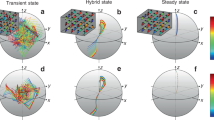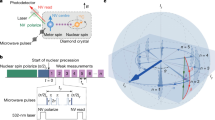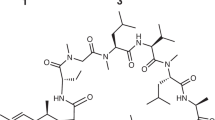Abstract
IT is well known1 that when a nuclear magnetic resonance signal is obtained in a rapidly rising magnetic field, the nuclei continue processing after resonance is passed. Their precessional frequency increases with the magnetic field, and while doing so forms beats with the exciting radio-frequency. These beats appear as ‘wiggles’ after passing the main resonance. In a perfectly homogeneous field, these wiggles die away exponentially at a rate determined by the relaxation time T22. T2 is related to the natural line-width by the relation T2 = 1/γΔH, where ΔH is the line-width and γ the gyromagnetic ratio of the nuclei being used. If the magnetic field is inhomogeneous by more than ΔH over the sample volume, say by ΔH, then the rate of decay of the wiggles is generally believed to be determined by the time, ∼1/γΔH. This has proved a limitation in the measurement of transverse relaxation times T2 ≫ 10−3 sec., as for such measurements a magnetic field inhomogeneity of ≲ 0.003 gauss is required; and, hitherto, this requirement has not been satisfied. Torrey3 has proposed and used a method in which long relaxation times T2 can be studied in the presence of an inhomogeneous magnetic field. The observation of his phenomenon depends on maintaining the magnetic field at resonance, and is quite unrelated to the ‘wiggles’ experiments.
This is a preview of subscription content, access via your institution
Access options
Subscribe to this journal
Receive 51 print issues and online access
$199.00 per year
only $3.90 per issue
Buy this article
- Purchase on Springer Link
- Instant access to full article PDF
Prices may be subject to local taxes which are calculated during checkout
Similar content being viewed by others
References
Bloembergen, Purcell and Pound, Phys. Rev., 73, 679 (1948).
Jacobsohn, B. A., and Wangsness, R. K., Phys. Rev., 73, 942 (1948).
Torrey, H. C., Phys. Rev., 76, 1059 (1949).
Author information
Authors and Affiliations
Rights and permissions
About this article
Cite this article
GOODEN, J. Nuclear Resonance and Magnetic Field Changes of 1 in 106. Nature 165, 1014–1015 (1950). https://doi.org/10.1038/1651014a0
Issue Date:
DOI: https://doi.org/10.1038/1651014a0
This article is cited by
-
A method for the measurement of the nuclear transversal relaxation time
Il Nuovo Cimento (1959)
Comments
By submitting a comment you agree to abide by our Terms and Community Guidelines. If you find something abusive or that does not comply with our terms or guidelines please flag it as inappropriate.



